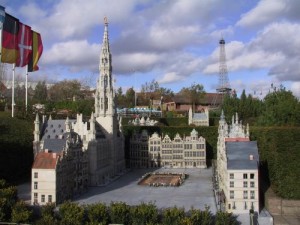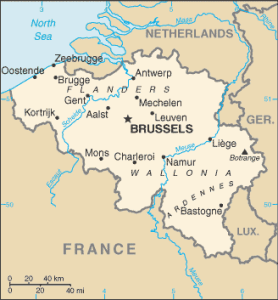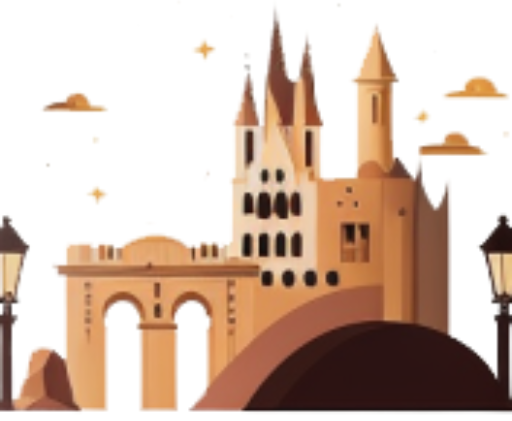 Belgium is a country in Western Europe, member of the Benelux. It is bordered by France to the south, the Grand Duchy of Luxembourg and Germany to the east, the Netherlands in the north and the North Sea to the west.
Belgium is a country in Western Europe, member of the Benelux. It is bordered by France to the south, the Grand Duchy of Luxembourg and Germany to the east, the Netherlands in the north and the North Sea to the west.
Populated by three linguistic communities unequally represented, Belgium also hosts the headquarters of some of the European institutions and NATO in Brussels, the capital. But language issues plague the country. Since antiquity influenced by the Germanic world (north) and the Latin world (south), the two main communities face the past fifty years in an apparently insoluble crisis. Of the country’s independence in 1830, the two world wars of the twentieth century, French was the dominant language economic exchanges, military, politics. Legitimate Dutch frustration of the country has found its climax in the 1960s, with the linguistic split the Catholic University of Leuven in 1968 (Louvain in French, including French equivalent was created a few years later under the name of Louvain-la-Neuve, Walloon Brabant) and the gradual separation of the country on both sides of the language border. Since a large part of the political elite Dutch caress the desire to deepen the federalization of the country until the final separation advocated by some. On the French side, the idea is gaining ground, but without enthusiasm.
The general climate of the country has a temperate maritime influence undergoing during most of the year. However, temperatures marked can be felt in July and January, depending on the year.
The name of almost all cities of Belgium have multiple versions of their name in the language of the city and one of the other languages of the country (or both). This is a little confusing for tourists, including French, because the city is not specified in the language of the region where it is but in the language of the region where the road sign. A city can change three or four times during a route name. This feature applies to border cities. If you are looking for Lille, you are likely to find yourself in a small village on the outskirts of Antwerp. It will go in seeking … Rijsel.
Map of Belgium
Ath
Antwerp (Antwerpen)
Arlon (Aarlen)
Bruges (Brugge)
Brussels, the capital (Brussels)
Charleroi
Eupen
Ghent (Gent)
Hasselt
Leuven (Leuven)
Liège (Luik)
Louvain-la-Neuve
Malmedy
Mechelen (Malines)
Mons (Bergen)
Mouscron (Moeskroen)
Namur (Namen)
Nivelles (Nijvel)
Oostende
Sankt-Vith (Saint-Vith)
Sint-Truiden (Sint-Truiden)
Tournai (Doornik)
Verviers
Wavre (Waver)
How to go ?
-By Bus
Eurolines offers rates that are among the lowest in the market and in any case often cheaper than airlines
-By plane
Belgium has five major airports and several military and civilian airfields for airplanes. It has a domestic airport, near Brussels, Zaventem, and four regional airport in Wallonia, Charleroi (Gosselies) and Liege (Bierset) and in Flanders, Antwerp (Deurne) and Ostend. All these airports serve international routes, but intercontinental flights leaving Brussels.
The Brussels National Airport, Brussels Airport renamed in 2006, is accessible from many European and international cities. From here you can reach the center of Brussels taxi (max € 25.00), by bus (€ 3.50) or by train (€ 5.40). There is a train every 15 minutes from the airport to Brussels and thence many Belgian cities, since the end of 2005 there is also a direct link to fast Leuven (2 times per hour Monday to Friday – otherwise every hour) .
Warning: Before leaving the Brussels National Airport, you can be approached by people offering you a taxi IGNORE THEM.! (If the font is in the corner, you will not see them) These people are pirates who try to bypass official taxis that they are just outside the airport.
Airport Charleroi-Brussels South specializes in the connections made by airlines to low cost, so-called “low-cost” in Franglais, to 15 European destinations (mainly with Ryanair). A link is provided by bus to the center of Charleroi (€ 1.80) and by bus to the Gare du Midi (10 EUR).
The Antwerp-Deurne Airport also offers a few scheduled flights, mainly to the United Kingdom but also Rotterdam and Milan.
The airports of Liège and Ostend instead proposed charter. Liege Airport is mainly specialized in the transport of freight.
– By boat
Ferry connections are available from Zeebrugge to Hull and Edinburgh, and from the port of Ostend to Ramsgate.
– By train
Many high-speed links to neighboring countries:
Thalys / TGV from Paris to Brussels-Midi, Liège-Cologne-Amsterdam and Antwerp, incidentally to Ghent, Bruges and Ostend and Brussels-Midi to the south of France. There is also a daily connection from Liege to Paris via Namur, Charleroi and Mons. Brussels-Midi station is the most important.
ICE from Frankfurt to Cologne via Brussels South and Liège.
Eurostar from London via Lille.
There are also conventional trains border from France, the Netherlands, Germany and the Grand Duchy of Luxembourg and day two connections from Brussels to Switzerland, via Namur and Arlon – with the terminus Basel – or Chur – via Zurich.
– By car
Belgium is connected to neighboring countries by a dense motorway network (about 1500 km) and often lit at night. Its road network is very dense and has more than 12,000 kilometers of roads.
What to visit in Belgium ?
Belgium has been inhabited since the earliest times of European prehistory. Crossing all time by migrant populations, it has experienced a strong Celtic influence through the Gauls. Invaded by the Romans, then by the Franks, it was twice the epicenter of the great kingdoms that prefigure medieval France and Germany: Clovis was born in Tournai line while Charlemagne is from Liège basin of the Meuse . At the end of the Middle Ages, the territory is divided, invaded, conquered and retaken by the French, Dutch, English, Spanish … In 1830, after the death throes of the French Empire (Waterloo, 1815) and the Dutch administration, the country became independent.
This perpetual crossroads were born a string of historic towns, almost all fortified, having experienced their heyday at different times, preserved in various ways. It is a kaleidoscope of history, shared ruined abbeys, private houses classified as World Heritage by UNESCO, a maze of medieval streets and remnants of the mining industry. Refer to the wiki every city is still the best way to prepare for the trip, unless to spend several weeks in the country.
Nature is against declines in four or five large geographical areas. The northern half of the country is characterized by a high population density, to the Belgian coast. Yet industrial surroundings channels today unusual offers beautiful walks. Birdwatchers can not miss the park Zwin on the coast. In the middle of the country, a large tract of land is divided between crops that made the country’s wealth before industrialization: cattle, grain, sugar beets, fruit through Hainault, Hesbaye and Condroz. Within this band, can not compare to the hills Tournaisis Liégeois! Further south, the Ardennes offers the walker rolling hills, rising to 694 meters to the east of the country. The far south is occupied by a Gaume reflections of French Lorraine, when this is not the Tuscany This is indeed where the vine is cultivated giving one of the few wines in the country- all cases the least well known.
Belgium finally sharing with neighboring Dutch one geocaches densities highest in the world.

